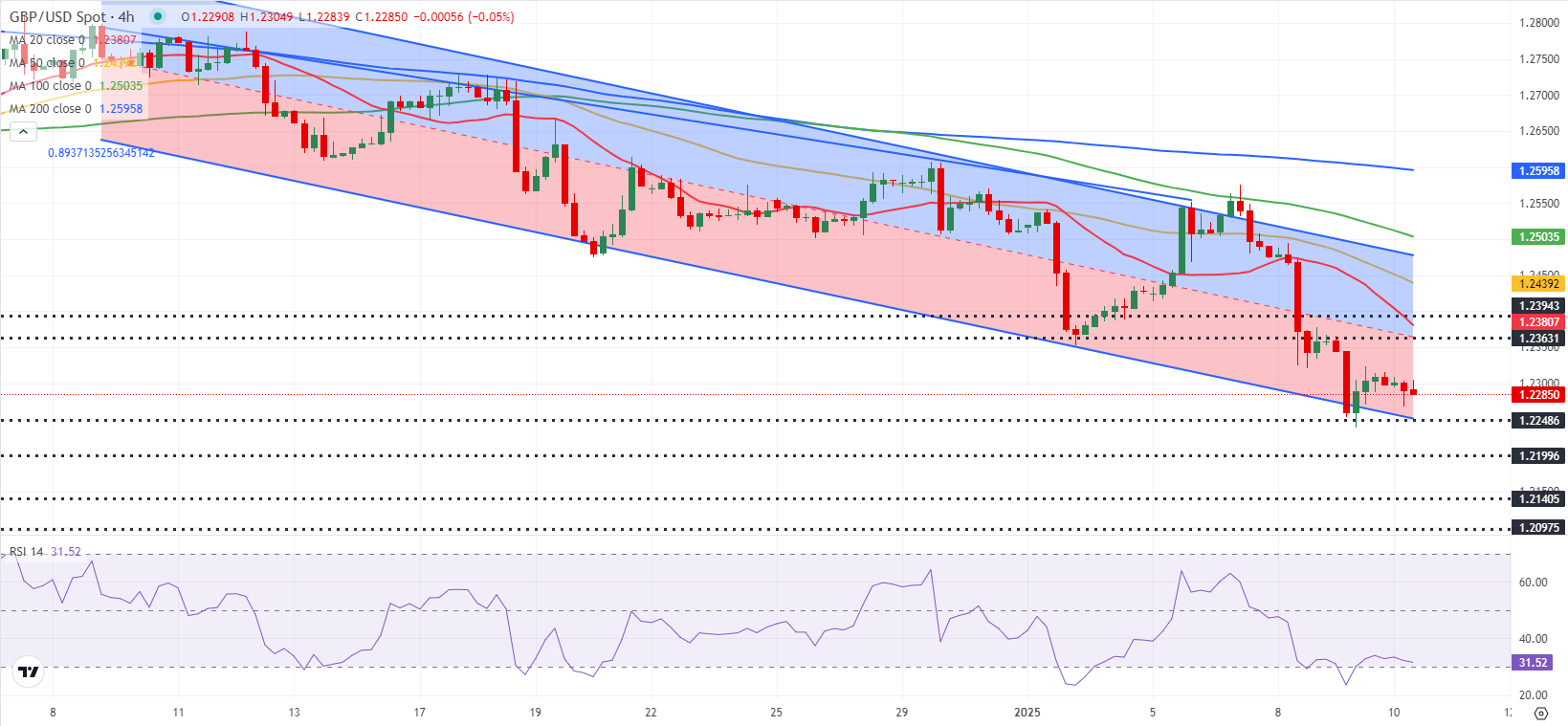- GBP/USD fluctuates near 1.2300 in the European morning on Friday.
- The 10-year UK gilt yield stays above 4.8%.
- December labor market data from the US will be watched closely by market participants.
After dipping to its weakest level since November 2023 below 1.2250 in the European session on Thursday, GBP/USD erased a portion of its losses in the second half of the day. The pair trades in a narrow channel at around 1.2300 on Friday as investors keep a close eye on the action in the UK gilt markets while waiting for December labor market data from the US.
British Pound PRICE This week
The table below shows the percentage change of British Pound (GBP) against listed major currencies this week. British Pound was the weakest against the Canadian Dollar.
| USD | EUR | GBP | JPY | CAD | AUD | NZD | CHF | |
|---|---|---|---|---|---|---|---|---|
| USD | 0.07% | 1.12% | 0.44% | -0.28% | 0.50% | 0.63% | 0.32% | |
| EUR | -0.07% | 1.04% | 0.33% | -0.29% | 0.48% | 0.60% | 0.29% | |
| GBP | -1.12% | -1.04% | -0.70% | -1.31% | -0.56% | -0.43% | -0.75% | |
| JPY | -0.44% | -0.33% | 0.70% | -0.68% | 0.11% | 0.26% | 0.13% | |
| CAD | 0.28% | 0.29% | 1.31% | 0.68% | 0.71% | 0.86% | 0.57% | |
| AUD | -0.50% | -0.48% | 0.56% | -0.11% | -0.71% | 0.12% | -0.19% | |
| NZD | -0.63% | -0.60% | 0.43% | -0.26% | -0.86% | -0.12% | -0.31% | |
| CHF | -0.32% | -0.29% | 0.75% | -0.13% | -0.57% | 0.19% | 0.31% |
The heat map shows percentage changes of major currencies against each other. The base currency is picked from the left column, while the quote currency is picked from the top row. For example, if you pick the British Pound from the left column and move along the horizontal line to the US Dollar, the percentage change displayed in the box will represent GBP (base)/USD (quote).
The selloff in the UK gilts continued early Thursday, causing Pound Sterling to weaken against its major rivals. In the European morning on Friday, the yield on the 10-year UK gilt stays in positive territory at around 4.85%. Another leg higher in this yield could trigger a new bout of selloff in GBP. On the other hand, a downward correction could help GBP/USD hold its ground.
The US Bureau of Labor Statistics will publish the December employment data in the early American session on Friday. The market expectation is for Nonfarm Payrolls to rise by 160,000 following the 227,000 increase reported in November. In the same period, the Unemployment Rate is seen holding steady at 4.2%.
A positive surprise in NFP, with a reading above 200,000, could help the USD gather strength and force GBP/USD to stay on the back foot heading into the weekend. On the flip side, the USD could come under pressure if the NFP arrives below 150,000. In this scenario, GBP/USD could stage a rebound later in the American session. Investors, however, could refrain from betting on a steady recovery until the UK gilt market settles down.
GBP/USD Technical Analysis
The Relative Strength Index (RSI) indicator on the 4-hour chart stays well below 40 and GBP/USD remains in the lower half of the one-month-old descending regression channel, highlighting the bearish bias.
On the downside, first support is located at 1.2250 (lower limit of the descending channel) before 1.2200 (static level, round level) and 1.2140 (static level from November 2023). Looking north, first resistance could be spotted at 1.2360 (mid-point of the descending channel) ahead of 1.2400 (round level, static level) and 1.2440 (50-period Simple Moving Average).
UK gilt yields FAQs
UK Gilt Yields measure the annual return an investor can expect from holding UK government bonds, or Gilts. Like other bonds, Gilts pay interest to holders at regular intervals, the ‘coupon’, followed by the full value of the bond at maturity. The coupon is fixed but the Yield varies as it takes into account changes in the bond's price. For example, a Gilt worth 100 Pounds Sterling might have a coupon of 5.0%. If the Gilt's price were to fall to 98 Pounds, the coupon would still be 5.0%, but the Gilt Yield would rise to 5.102% to reflect the decline in price.
Many factors influence Gilt yields, but the main ones are interest rates, the strength of the British economy, the liquidity of the bond market and the value of the Pound Sterling. Rising inflation will generally weaken Gilt prices and lead to higher Gilt yields because Gilts are long-term investments susceptible to inflation, which erodes their value. Higher interest rates impact existing Gilt yields because newly-issued Gilts will carry a higher, more attractive coupon. Liquidity can be a risk when there is a lack of buyers or sellers due to panic or preference for riskier assets.
Probably the most important factor influencing the level of Gilt yields is interest rates. These are set by the Bank of England (BoE) to ensure price stability. Higher interest rates will raise yields and lower the price of Gilts because new Gilts issued will bear a higher, more attractive coupon, reducing demand for older Gilts, which will see a corresponding decline in price.
Inflation is a key factor affecting Gilt yields as it impacts the value of the principal received by the holder at the end of the term, as well as the relative value of the repayments. Higher inflation deteriorates the value of Gilts over time, reflected in a higher yield (lower price). The opposite is true of lower inflation. In rare cases of deflation, a Gilt may rise in price – represented by a negative yield.
Foreign holders of Gilts are exposed to exchange-rate risk since Gilts are denominated in Pound Sterling. If the currency strengthens investors will realize a higher return and vice versa if it weakens. In addition, Gilt yields are highly correlated to the Pound Sterling. This is because yields are a reflection of interest rates and interest rate expectations, a key driver of Pound Sterling. Higher interest rates, raise the coupon on newly-issued Gilts, attracting more global investors. Since they are priced in Pounds, this increases demand for Pound Sterling.
Information on these pages contains forward-looking statements that involve risks and uncertainties. Markets and instruments profiled on this page are for informational purposes only and should not in any way come across as a recommendation to buy or sell in these assets. You should do your own thorough research before making any investment decisions. FXStreet does not in any way guarantee that this information is free from mistakes, errors, or material misstatements. It also does not guarantee that this information is of a timely nature. Investing in Open Markets involves a great deal of risk, including the loss of all or a portion of your investment, as well as emotional distress. All risks, losses and costs associated with investing, including total loss of principal, are your responsibility. The views and opinions expressed in this article are those of the authors and do not necessarily reflect the official policy or position of FXStreet nor its advertisers. The author will not be held responsible for information that is found at the end of links posted on this page.
If not otherwise explicitly mentioned in the body of the article, at the time of writing, the author has no position in any stock mentioned in this article and no business relationship with any company mentioned. The author has not received compensation for writing this article, other than from FXStreet.
FXStreet and the author do not provide personalized recommendations. The author makes no representations as to the accuracy, completeness, or suitability of this information. FXStreet and the author will not be liable for any errors, omissions or any losses, injuries or damages arising from this information and its display or use. Errors and omissions excepted.
The author and FXStreet are not registered investment advisors and nothing in this article is intended to be investment advice.
Recommended Content
Editors’ Picks

How will US Dollar react to December Nonfarm Payrolls data? – LIVE
Nonfarm Payrolls in the US are expected to rise 160,000 in December. The details of the jobs report could reaffirm whether the labor market conditions are tight enough for the Fed to approach policy easing more cautiously in 2025 and drive the US Dollar's valuation.

EUR/USD holds near 1.0300 as traders await US NFP
EUR/USD trades in a tight channel at around 1.0300 in the European session on Friday. However, concerns over US President-elect Trump's policies and hawkish Fed expectations keep the US Dollar afloat ahead of the Nonfarm Payrolls data, capping the pair's upside.

GBP/USD struggles to stay above 1.2300, eyes on US jobs report
GBP/USD finds it difficult to gather recovery momentum after rising above 1.2300 earlier in the day. The pair remains vulnerable amid persistent US Dollar strength and the UK bond market turmoil. The focus now shifts to the US labor market data for fresh directives.

Gold climbs to fresh multi-week high above $2,680 ahead of US NFP
Gold price (XAU/USD) gains some follow-through positive traction for the fourth consecutive day and trades at its highest level in nearly a month above $2,680. Market focus shifts to US labor market data, which will feature Nonfarm Payrolls and wage inflation figures.

How to trade NFP, one of the most volatile events Premium
NFP is the acronym for Nonfarm Payrolls, arguably the most important economic data release in the world. The indicator, which provides a comprehensive snapshot of the health of the US labor market, is typically published on the first Friday of each month.

Best Forex Brokers with Low Spreads
VERIFIED Low spreads are crucial for reducing trading costs. Explore top Forex brokers offering competitive spreads and high leverage. Compare options for EUR/USD, GBP/USD, USD/JPY, and Gold.
